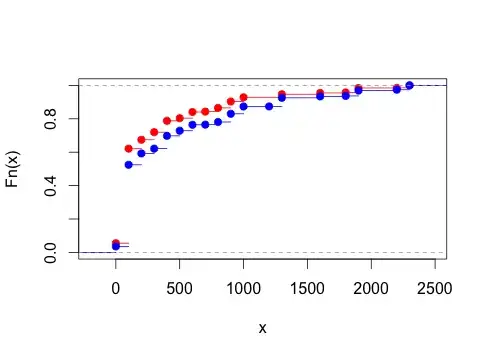I have a location of landmark in 2D. According to Extended Kalman Filter EKF- SLAM, if the robot re-observes the same landmark, the covariance ellipse will shrink. I collected the necessary information and I would like to know how the covariance ellipse is drawn. The location of a landmark is $<\!x:30,y:60\!>$. Now for the first time the robot detects the location the following information is gathered.
$$ \mu_{x} = 28.8093 \\ \mu_{y} = 60.6267 \\ Cov(x,y) = \begin{bmatrix} 1.68165 & -0.793713 \\ -0.793713 & 0.388516 \\ \end{bmatrix} $$
I stored all the values in txt file. What is the formula for drawing the covariance?
Some samples from the experiment.
\mu_{x} \mu_{y} \sigma_{xx} \sigma_{xy} \sigma_{yx} \sigma_{yy}
---------------------------------------------------------------------------------
28.8093 60.6267 1.68165 -0.793713 -0.793713 0.388516
29.0079 60.5671 1.56697 -0.740083 -0.740083 0.358862
29.0511 60.5439 1.54802 -0.732739 -0.732739 0.353890
29.0148 60.5132 1.54433 -0.732171 -0.732171 0.352841
28.9692 60.4775 1.54340 -0.732399 -0.732399 0.352388
28.948 60.4577 1.54311 -0.732623 -0.732623 0.352052
28.9527 60.4621 1.54300 -0.732781 -0.732781 0.351782
28.9514 60.4602 1.54290 -0.732913 -0.732913 0.351591
28.9506 60.4596 1.54283 -0.733016 -0.733016 0.351445
28.9474 60.4539 1.54279 -0.733090 -0.733090 0.351320
Edit:
I have found this Matlab Code for drawing what I'm looking for but I don't understand the rule of Choleski method in the code.
NP = 16;
alpha = 2*pi/NP*(0:NP);
circle = [cos(alpha);sin(alpha)];
ns = 3;
x = [28.8093 ;60.626];
P = [1.68165 -0.793713;-0.793713 0.388516];
C = chol(P)'; %Choleski method <-????????????
ellip = ns*C*circle;
X = x(1)+ellip(1,:);
Y = x(2)+ellip(2,:);
The result is in the below picture which is exactly what I'm looking for but what is the rule of Choleski method in the code?
